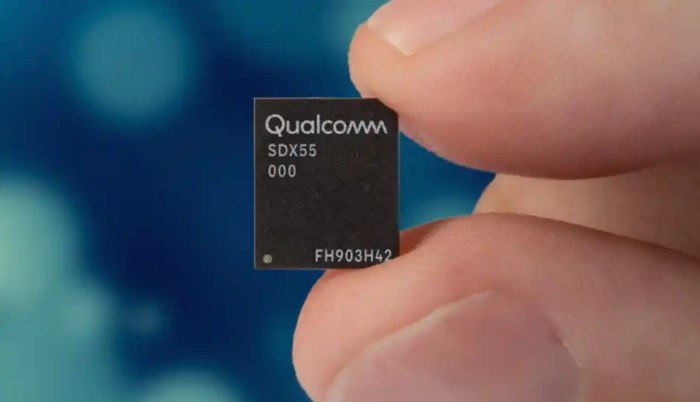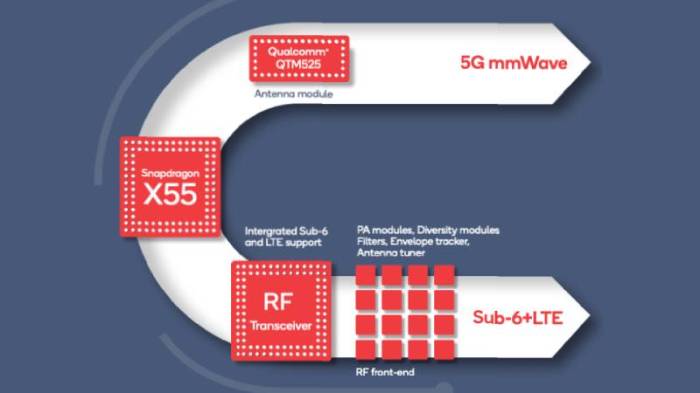Qualcomm X55 Modem MWC19: Remember 2019? Before 5G was *everywhere*, Qualcomm dropped the X55, a modem promising blazing-fast speeds and low latency. This wasn’t just another upgrade; it was a leap forward, a key player in ushering in the era of next-gen connectivity. We’re diving deep into its features, impact, and legacy, exploring why this little chip made such a big splash.
From its impressive specs to its role in early 5G deployments, the X55 redefined what was possible. We’ll unpack its technological advancements, compare it to its predecessors, and analyze its reception within the industry. Get ready for a nostalgic tech trip back to the dawn of widespread 5G.
Technological Advancements in the X55
The Qualcomm Snapdragon X55 5G modem, unveiled at MWC19, represented a significant leap forward in mobile connectivity. It wasn’t just an incremental upgrade; it was a showcase of Qualcomm’s commitment to pushing the boundaries of what 5G could achieve, paving the way for faster speeds, improved reliability, and enhanced power efficiency. This advancement built upon previous generations, addressing limitations and delivering a truly next-generation experience.
The X55 boasted impressive 5G capabilities, supporting both sub-6 GHz and mmWave frequencies. This dual-connectivity was crucial, as it allowed devices to seamlessly switch between the two frequency bands depending on availability and signal strength. Sub-6 GHz offered wider coverage, while mmWave provided significantly higher speeds, ideal for bandwidth-intensive applications. This flexibility ensured a consistently robust and high-performance connection, even in challenging environments. The modem’s ability to aggregate multiple frequency bands further boosted data throughput, achieving peak download speeds exceeding 7Gbps. This translates to significantly faster downloads, smoother streaming, and more responsive online experiences, especially in densely populated areas or situations with high network congestion.
Antenna Technologies and Performance
The X55 integrated advanced antenna technologies to maximize signal quality and minimize interference. Qualcomm incorporated features like beamforming and beam tracking, which dynamically adjust the signal direction to optimize connection strength. This is particularly beneficial in mmWave environments, where signals are more susceptible to obstruction. Imagine a scenario where you’re walking down a busy street; beamforming and beam tracking would ensure a consistent connection by constantly adjusting the signal to compensate for obstacles like buildings or other people. Furthermore, the modem supported massive MIMO (multiple-input and multiple-output), allowing for the use of multiple antennas at both the transmitter and receiver ends. This dramatically increased data capacity and spectral efficiency, resulting in faster speeds and a more reliable connection, even in areas with many users competing for the same network resources.
Power Efficiency Improvements
Power consumption is a critical consideration for mobile devices. The X55 demonstrated significant improvements in power efficiency compared to its predecessors. Qualcomm achieved this through a combination of advanced power management techniques and optimized hardware design. This resulted in extended battery life for devices equipped with the X55, even while supporting demanding 5G connections. For example, in scenarios like streaming high-definition video or downloading large files, the improved power efficiency translated to noticeably longer usage times before needing a recharge. This was a significant step forward, addressing a common concern regarding 5G’s higher power consumption. The efficiency gains were not just noticeable in high-bandwidth scenarios; even during periods of low activity, the X55 demonstrated better power management, contributing to overall improved battery performance.
Impact and Reception of the X55
The Qualcomm Snapdragon X55 5G modem, unveiled at MWC19, didn’t just generate ripples; it created a tidal wave in the telecommunications industry. Its announcement signaled a significant leap forward in 5G technology, promising speeds and capabilities previously relegated to science fiction. The immediate reaction was a mix of awe and anticipation, with industry analysts and tech journalists alike praising its potential to revolutionize mobile connectivity. The sheer breadth of its capabilities, encompassing both mmWave and sub-6GHz frequencies, immediately set it apart from the competition.
The initial response from the industry was overwhelmingly positive. Many saw the X55 as a crucial component in the rollout of truly global 5G networks, capable of handling the diverse spectrum deployments planned across the world. Trade publications lauded its advanced features, highlighting its potential for improved network performance, lower latency, and enhanced power efficiency – all key factors influencing consumer adoption of 5G technology. The excitement wasn’t just confined to industry experts; consumers, too, were intrigued by the promise of faster downloads, smoother streaming, and more reliable connections.
Early Device Adoption and Integration
The X55’s impact wasn’t just theoretical; it quickly translated into real-world applications. Several major smartphone manufacturers integrated the X55 into their flagship devices launched throughout 2019 and 2020. For example, early adopters included premium smartphones from brands like Samsung and Motorola, which leveraged the X55’s capabilities to deliver cutting-edge 5G connectivity to their customers. This rapid integration demonstrated the modem’s maturity and its readiness for mass market deployment. The speed at which the X55 was incorporated into commercially available devices highlighted its robust design and the confidence manufacturers had in its performance. This widespread adoption cemented the X55’s position as a leading 5G modem solution.
Hypothetical Marketing Campaign: Unleash the Power of 5G
Imagine a marketing campaign centered around the theme “Unleash the Power of 5G.” The campaign would focus on showcasing the tangible benefits of the X55 for everyday consumers. Visuals would depict scenarios where the X55’s superior speed and reliability make a real difference: seamless video calls with family across continents, instant downloads of large files, lag-free online gaming, and uninterrupted streaming of high-definition content, even in crowded areas. The campaign would emphasize the X55’s role in powering these experiences, highlighting its advanced technology in an easily understandable way. Slogans such as “Download the Future” or “Experience 5G, Unleashed” could be used to capture the essence of the X55’s power and impact on the user experience. This campaign would be multi-platform, leveraging social media, television commercials, and online advertising to reach a broad audience. Testimonials from satisfied users would add a layer of authenticity and further reinforce the X55’s value proposition. The campaign would also focus on the reliability and consistent performance aspects of the X55, a key differentiator in a world where dropped calls and buffering are major pain points.
Technical Specifications and Architecture: Qualcomm X55 Modem Mwc19
The Qualcomm Snapdragon X55 5G modem, unveiled at MWC19, represented a significant leap forward in mobile connectivity. Its architecture was meticulously designed to handle the complexities of 5G networks, delivering blazing-fast speeds and reliable performance. Understanding its internal workings reveals the innovative engineering behind this groundbreaking technology.
The X55’s architecture is based on a highly integrated system-on-a-chip (SoC) approach, consolidating numerous components onto a single die. This approach minimizes power consumption and improves efficiency, crucial for extended battery life in mobile devices. The integration of various functions also enhances the overall performance and reduces latency.
Internal Components and Interconnections
Imagine the X55 as a sophisticated city, with different specialized districts working together seamlessly. At its core lies the central processing unit (CPU), the city’s central government, managing and coordinating all operations. Surrounding it are specialized districts: the digital signal processor (DSP), handling the complex signal processing; the radio frequency (RF) transceiver, responsible for communication with the cellular towers; and the memory units, storing data and instructions. High-speed data highways – buses – connect these districts, enabling rapid information exchange. The power management unit, like the city’s power grid, ensures efficient energy distribution, optimizing battery life. Finally, the security engine acts as the city’s police force, protecting against unauthorized access and ensuring data integrity. This interconnected system works in concert to deliver optimal 5G performance. A simplified textual representation might look like this:
“`
+—————–+
| CPU |
+——–+——–+
| |
| |
+——-+——–+——-+
| | | |
+——-v——-+——–+——-v——-+
| DSP | RF Transceiver | Memory
+—————+———————+
|
|
+—————+
| Power Mgmt Unit|
+—————+
|
+—————+
| Security Engine|
+—————+
“`
Contribution to Network Performance and User Experience, Qualcomm x55 modem mwc19
The X55’s features directly translate to enhanced network performance and a superior user experience. Its support for both mmWave and sub-6 GHz 5G frequencies provides flexibility and wider coverage. The advanced antenna technology, coupled with beamforming capabilities, ensures strong signal reception even in challenging environments. This translates to faster download and upload speeds, reduced latency for lag-free gaming and video streaming, and improved reliability for seamless connectivity. The higher peak data rates enabled by the X55 allow users to download large files in seconds and stream high-definition video without buffering. The improved power efficiency extends battery life, allowing users to stay connected for longer periods. The integrated security features safeguard user data, providing a more secure and trustworthy mobile experience. For instance, a user could download a high-resolution movie in a fraction of the time compared to previous generation technologies, all while experiencing minimal battery drain and secure data transmission.
The Qualcomm X55 modem, unveiled at MWC19, wasn’t just a product; it was a pivotal moment. It showcased Qualcomm’s commitment to 5G leadership, paving the way for future generations of modems and fundamentally altering the mobile landscape. While newer tech exists, the X55’s impact remains significant, a testament to its innovative design and crucial role in the 5G revolution. Its legacy echoes in the speed and reliability we expect from our mobile devices today.
 Tech Nest Online Berita Teknologi Terbaru
Tech Nest Online Berita Teknologi Terbaru

